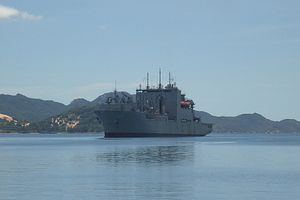On Tuesday, Vietnam inaugurated an international port facility capable of receiving foreign warships at Cam Ranh Bay along the South China Sea.
An opening ceremony was held to mark the completion of the first construction phase of the facility, called Cam Ranh International Port, located in Cam Ranh Bay, a deep-water harbor in central Vietnam along the South China Sea. The ceremony was attended by Vietnamese President Truong Tan Sang along with several high-ranking military leaders.
The much-anticipated move, which was initially approved by Vietnam’s defense ministry back in September 2014, is part of an ongoing effort by Hanoi to build a new dual-use facility that can accommodate and service foreign ships. The port facility would allow Vietnam to both boost its commercial attractiveness as a hub for ships as well as increase naval engagements with foreign countries amid China’s growing assertiveness in the South China Sea.
“The inauguration of the port will not only support nation building and its protection but also make it one of Vietnam’s leading deep-sea ports and supply service areas,” Sang said in his remarks at the ceremony according to Vietnam News.
Several countries had already expressed interest in potential access to the facility even before its completion. In 2012, former U.S. Secretary of Defense Leon Panetta said during an historic visit to Cam Ranh Bay that access for U.S. naval ships into this facility is “a key component” of the U.S.-Vietnam relationship. The United States had used Cam Ranh Bay as a base during the Vietnam War, before the then-Soviet Union leased it following the end of the war in 1975.
But while U.S.-Vietnam defense relations have intensified over the past few years, Washington is still seeking the ability for U.S. naval vessels to make port calls or secure access to Cam Ranh Bay (See: “What’s Next for US-Vietnam Relations?”). U.S. president Barack Obama is expected to visit Vietnam in May (See: “Obama Will Visit Vietnam in May 2016 to Boost Ties”).
Apart from the United States, last year, an agreement was also reached between Vietnam and Japan for Japanese vessels to make port calls in Cam Ranh Bay (See: “Japan Warships Could Visit Vietnam Naval Base Near South China Sea in 2016”). As I noted then, the move was just the latest in a series of steps the two sides have taken to boost their defense relationship. Earlier this week, reports suggested that two Japanese warships would sail to Vietnam’s Cam Ranh Bay in April after first arriving in Subic Bay in the Philippines, another former U.S. base (See: “Japanese Submarine to Visit Philippines Amid South China Sea Tensions”).
Vietnamese defense officials, keen to preserve the country’s key objective of diversifying and multilateralizing its foreign relations and avoid antagonizing China, have repeatedly stressed the dual-use nature of the facility (despite the often singular emphasis on the military component) and that it would be open to all – not just a few – countries. They have also emphasized that the new port facility is separate from the country’s naval base, which is also located in Cam Ranh.
Though details of the new facility have not been publicly disclosed, The Diplomat understands that it has piers that will be able to receive aircraft carriers as well as submarines. Other facilities, including a repair base, warehouse, and an international maritime exhibition center are also expected to be built.
There has been no public confirmation on the final date for the completion of the second phase of the project. But Vietnamese officials, including President Sang himself, have unsurprisingly sought to emphasize the less controversial commercial component of the port facility in public remarks, including its ability to attract commercial ships for repair and refueling and becoming a model for future ports.
“We must promote the Cam Ranh international port to the world to attract major shipping brands to come to Cam Ranh for maintenance, repair, and refueling, including fresh water and food,” Sang said in his address at the opening ceremony.
According to official estimates, the total investment for the project is around two trillion dong ($89.7 million), with a quarter of that coming from PetroVietnam and the rest from Saigon New Port Corporation. Upon completion, the port, expected to be the largest in Vietnam by wharf length, will serve as a key naval maintenance and logistics facility for foreign warships, handling 18 ships at a time and receiving 185 ships annually.

































